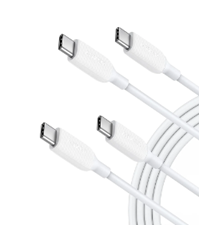In the realm of modern technology, the type
of cable you choose can have a significant impact on your overall user
experience. With a plethora of options available, it's crucial to understand
the advantages and disadvantages of each. USB-C stands out as a versatile and
powerful standard among the contenders, but how does it compare to other
cables? In this article, we'll embark on a journey to explore the battle of
USB-C versus other cables, delving into their respective strengths and
applications.
The Contenders:
USB-C, Micro-USB, and Lightning
Before diving into the showdown, let's
introduce our contenders:
USB-C
Known for its reversibility and high-speed
capabilities, USB-C has become the standard for connectivity in modern devices.
It's used in many products, including smartphones, laptops, tablets, and more.

Micro-USB
Widely adopted in previous generations of
devices, micro-USB cables have a distinctive trapezoidal shape. While they're
still prevalent, especially in older devices, they lack the speed and
versatility of USB-C.
Lightning
Exclusive to Apple devices, Lightning
cables have a compact design with eight pins. They're known for their
durability and compatibility with a variety of Apple products, including
iPhones, iPads, and iPods.
Respective
Features
Reversibility:
USB-C Takes the Lead
One of the standout features of USB-C is
its reversibility. Unlike its predecessors, which require a precise alignment
for a successful connection, USB-C can be plugged in either way. This not only
saves time and frustration but also eliminates the risk of damaging the
connector due to incorrect insertion. In this category, USB-C clearly reigns
supreme.
Speed and
Versatility: USB-C's Power Play
When it comes to speed, USB-C leaves its
competitors in the dust. It supports a wide range of USB standards, including
USB 2.0, USB 3.0/3.1 Gen 1, USB 3.1 Gen 2, and USB 3.2, with varying maximum
data transfer rates. This makes USB-C suitable for a multitude of tasks, from
basic charging to high-speed data transfer and even video output. Micro-USB,
while functional, falls behind in terms of speed and versatility.

Apple Ecosystem
Integration: Lightning Holds Its Ground
For Apple users, the Lightning cable is an
integral part of the ecosystem. It's compatible with a wide range of Apple
devices, providing a seamless experience for charging, data transfer, and even
audio transmission. While USB-C is becoming more prevalent in the Apple lineup,
Lightning remains a strong contender within the Apple ecosystem.
Widespread
Adoption: The Rise of USB-C
In recent years, USB-C has seen widespread
adoption across various industries. It's the standard connector for Android
smartphones, laptops, tablets, and accessories. Additionally, major tech
companies have embraced USB-C, making it a universal choice for connectivity.
Micro-USB, while still prevalent in older devices, is gradually being phased
out in favor of USB-C.
Durability and
Longevity: A Shared Endeavor
Both USB-C and Lightning cables are known
for their durability. They're designed to withstand daily use and are less
prone to wear and tear compared to their predecessors. Micro-USB, while
functional, maybe slightly less robust in terms of connector design.
Conclusion: The
Reign of USB-C
In the battle of USB-C versus other cables,
usb c emerges as the
clear victor for modern tech enthusiasts. Its reversible design, high-speed
capabilities, and versatility make it an essential standard for a wide range of
devices. While other cables like Micro-USB and Lightning have their merits,
USB-C's widespread adoption and future-ready design position it as the reigning
champion in the ever-evolving landscape of modern technology. As we continue to
witness the transition to USB-C across the tech industry, it's clear that this
versatile connector is here to stay. Embrace the power and potential of USB-C,
and unlock a new level of connectivity and efficiency in your tech-powered
life.
